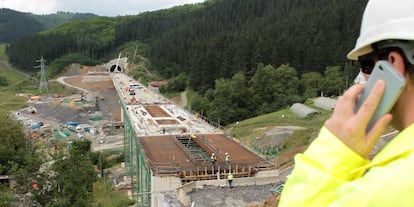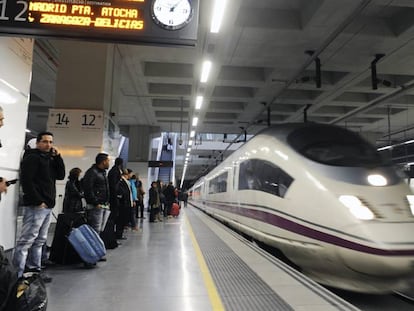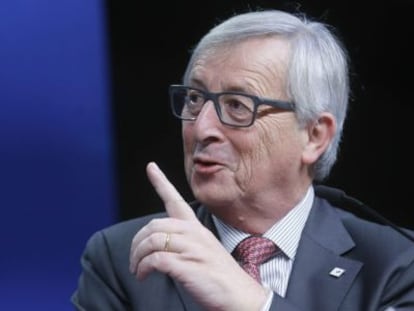The Basque Y: the very slow tale of a very fast train
Three decades on, high-speed rail link in northern Spain is still far from reaching its destination
When it comes to the Basque Country’s AVE high-speed rail project, known popularly as “the Basque Y” because of the shape of its network, this is definitely a case of what Bob Dylan might call A Slow Train Coming. In 1989 it was one of the first major rail projects to be approved, but work did not begin until 2004. Now, 27 years later, the line still has no date for its inaugural run.

Once targeted by the terrorist group ETA, work was also delayed by technical problems and political fallouts. Now it is seen as a gauge of the thaw between the conservative Popular Party (PP) central government and the Basque Nationalist Party (PNV): the latter is demanding completion of the project in return for supporting the Popular Party’s budget.
In a dramatic U-turn from the categorical pronouncement last September that “we don’t finance pharaonic works,” made by then-Public Works Minister Rafael Catalá, his successor, Iñigo de la Serna, said last month: “We want to work together to speed up the job.”
A kilometer of high-speed track costs €23 million to build in the Basque Country
With a budget of €4.2 billion agreed at the start of the project, the infrastructure will link the Basque Country’s three capitals, Bilbao, Vitoria and San Sebastián. But problems with access into the cities have held up the project; there are stretches of track that still have not been put out to tender, and there is no high-speed link to the rest of the country‘s high-speed network.
However, the project now has the chance to get back on track and pick up a head of steam. The government of Prime Minister Mariano Rajoy needs support for its budget and the PNV is prepared to do a deal if the cabinet is prepared to take steps toward completing the high-speed project.
The Basque commissioner for Economic Development and Infrastructure, Arantxa Tapia, has already asked for a meeting with Economy Minister Luis de Guindos and De la Serna to make plans, though she has received no reply as yet.
PNV leader Andoni Ortuzar has said that developing a “stable” working relationship with the central government will depend on whether the train issue is resolved. He also noted that the main negotiations will take place in January and February.
We want to work together to speed up the job Iñigo de la Serna, Public Works Minister
The project is included in the 2005-2020 National Strategic Plan for Infrastructure, and is of relevance to the EU as an Atlantic axis point.
More than 100 km of a total of 175km will run through 23 tunnels, and a further 44 viaducts are in the works. Once it is completed, the Basque Y will allow passengers to travel between San Sebastián and Bilbao in under 40 minutes, a journey which currently takes more than 90 minutes.
Obstacles include costs, technical problems and environmental impact – not only does the project have its share of critics, but the 164,647m2 of land that has been laid to waste in the process must be regenerated. One kilometer of high-speed track costs an average of €23 million in the Basque Country but just €13 million in the rest of the country.
The PNV and Basque Socialists (PSE) want a deal to finish the job, including using money from the quota the Basque government contributes to central government for undevolved powers. The hope now is trains will start operating five years down the line.
English version by Heather Galloway.
Tu suscripción se está usando en otro dispositivo
¿Quieres añadir otro usuario a tu suscripción?
Si continúas leyendo en este dispositivo, no se podrá leer en el otro.
FlechaTu suscripción se está usando en otro dispositivo y solo puedes acceder a EL PAÍS desde un dispositivo a la vez.
Si quieres compartir tu cuenta, cambia tu suscripción a la modalidad Premium, así podrás añadir otro usuario. Cada uno accederá con su propia cuenta de email, lo que os permitirá personalizar vuestra experiencia en EL PAÍS.
¿Tienes una suscripción de empresa? Accede aquí para contratar más cuentas.
En el caso de no saber quién está usando tu cuenta, te recomendamos cambiar tu contraseña aquí.
Si decides continuar compartiendo tu cuenta, este mensaje se mostrará en tu dispositivo y en el de la otra persona que está usando tu cuenta de forma indefinida, afectando a tu experiencia de lectura. Puedes consultar aquí los términos y condiciones de la suscripción digital.
More information
Últimas noticias
The complicated life of Francesca Albanese: A rising figure in Italy but barred from every bank by Trump’s sanctions
How Japan is trying to avert ‘digital defeat’
Half of Scotland is in the hands of 420 property owners
Reinhard Genzel, Nobel laureate in physics: ‘One-minute videos will never give you the truth’
Most viewed
- Pablo Escobar’s hippos: A serious environmental problem, 40 years on
- Why we lost the habit of sleeping in two segments and how that changed our sense of time
- Charles Dubouloz, mountaineering star, retires at 36 with a farewell tour inspired by Walter Bonatti
- Reinhard Genzel, Nobel laureate in physics: ‘One-minute videos will never give you the truth’
- The Florida Keys tourist paradise is besieged by immigration agents: ‘We’ve never seen anything like this’











































